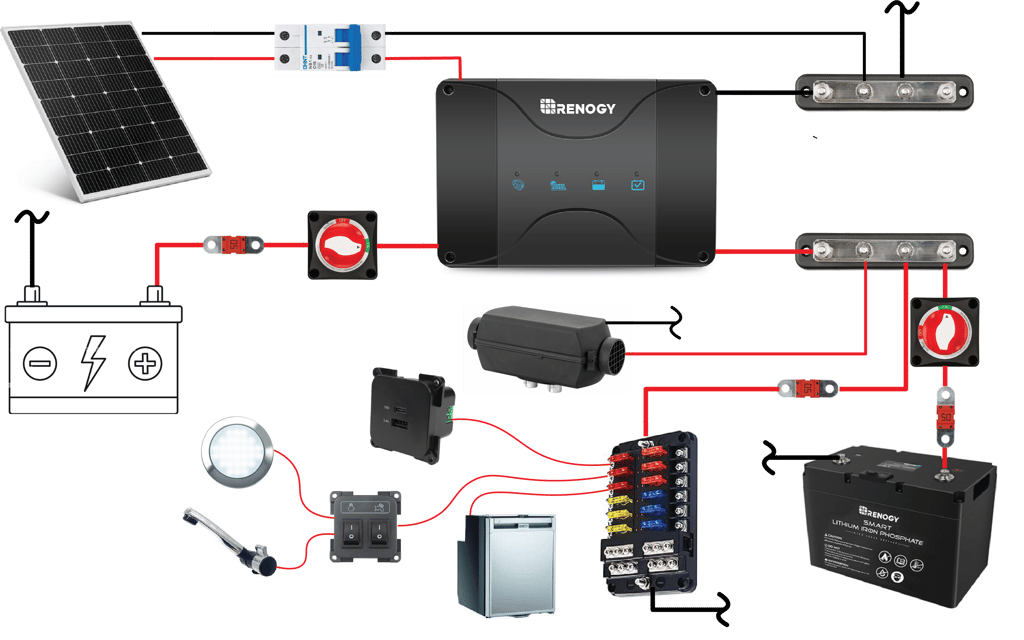Campervan Power System Design
A straight forward Renogy Lithium power setup which is perfect for all vans and is suitable for spending time off grid.


Full specifications and cable sizing can be found at the end of this article.
"Disclaimer: Installing electrical equipment in a campervan requires technical know-how and an understanding of automotive electrical systems. Improper installation may pose risks such as electrical hazards, fire, damage to the vehicle and personal injury. It is recommended to seek guidance from a professional or thoroughly educate yourself before proceeding with any electrical modifications or installations."
The diagram above illustrates a high quality and cost efficient power system which is ideal for campervans and motorhomes. The system benefits from a Renogy 100Ah Lithium battery, the lithium battery may appear to be substantially more expensive when compared to other batteries however it provides abundant power and offers a long warranty reducing the requirement for any future spending. (Lithium Vs. AGM)
Selecting a power system for your van requires thoughtful consideration of its intended use. Overspecification of systems can lead to unnecessary costs, therefore, estimating your typical van usage is crucial to avoid expenses beyond your budget. This design includes a 200W solar panel, this can be upgraded if desired as the Renogy controller can accommodate over 300W of solar input. Alternatively, the charge controller can be upgraded to the 50A model if required.
Unless there is a requirement for prolonged winter usage or the desire to run high powered electrical appliances we would not recommend installing a mains hook-up due to the additional cost. Nevertheless, these features can be easily integrated during the initial build or retrofitted at a later date. The Renogy 100Ah battery benefits from Bluetooth connectivity and a built-in battery monitor which can be viewed through the Renogy DC home app, this is a great feature as you can monitor your exact usage without the need to install an energy monitor. If you would like to see live usage and power levels without looking at your phone, the Renogy Home panel or a shunt energy monitor can be added.
The total cost (including cables) is £1021 (as of March 2024). Installing this system should be achievable within 2 days depending on the layout of your van. If you're not confident about installing it yourself we'd be glad to discuss how we could help and offer a quote. (All appliances, lighting and outlets are additional to this cost)
Please note, Brento doesn't have an affiliation with any of the companies listed below. However, based on our experience, they offer great products at competitive prices.
To install this system you will need a range of basic tools, and equipment. Having a mix of crimps, terminals, and heat shrink tubing is useful. The list below should provide more than enough consumable items, by planning carefully, you could save money by purchasing specific items separately. Yet, having a variety of parts available ensures the job runs without any delays.
If you haven't worked with automotive electrics before, you might not have the necessary tools for the job. Here are some essential tools vital for a safe and effective installation.
If you'd like to install this system yourself, please read the following notes. It might be possible to reduce cable sizes; however, the current sizes allow it to be installed in any sized van with minimal voltage drop. Sizes have also been standardised to reduce the number of different cables required during the installation.
Notes-
All battery/DC-DC cables are to be PVC high flex battery cable 6AWG/16mm2 unless otherwise stated.
The lighting, water pump and USB can be supplied from a common power supply however individual supplies provide redundancy in the system, preventing a total power loss due to a single fault.
Diesel heaters should be connected directly to the battery without an isolation switch. Isolating the power supply of a diesel heater during operation may cause irreparable damage to the device.
Appliances -
USB Outlet - 3A Fuse and 16AWG/1.50mm2 cable
Fridge - Fridges are sold with suitable cables and fuses. Follow manufacturer guidance if this cable needs to be extended.
Lights - For a larger van 6 low wattage LED spotlights should be sufficient, connect using a 5A Fuse and 16AWG/1.50mm2 cable
Water Pump - Follow manufacturer guidance on fuse and cable size. This will differ between manufacturers and models. A small submersible pump typically requires a 5A fuse and 16AWG/1.50mm2 cable
Diesel Heater - Heaters are provided with a suitable cable and fuse. If you need to extend the cable, voltage drop can cause faults during start up due to the high current draw. Consult the manufacturer's instructions if modifying the wiring harness. For help choosing a heater read the following article.
Contact Us
Get in touch with us to discuss your requirements.
Tel: 07917 840089
Email: info@brento.co.uk


